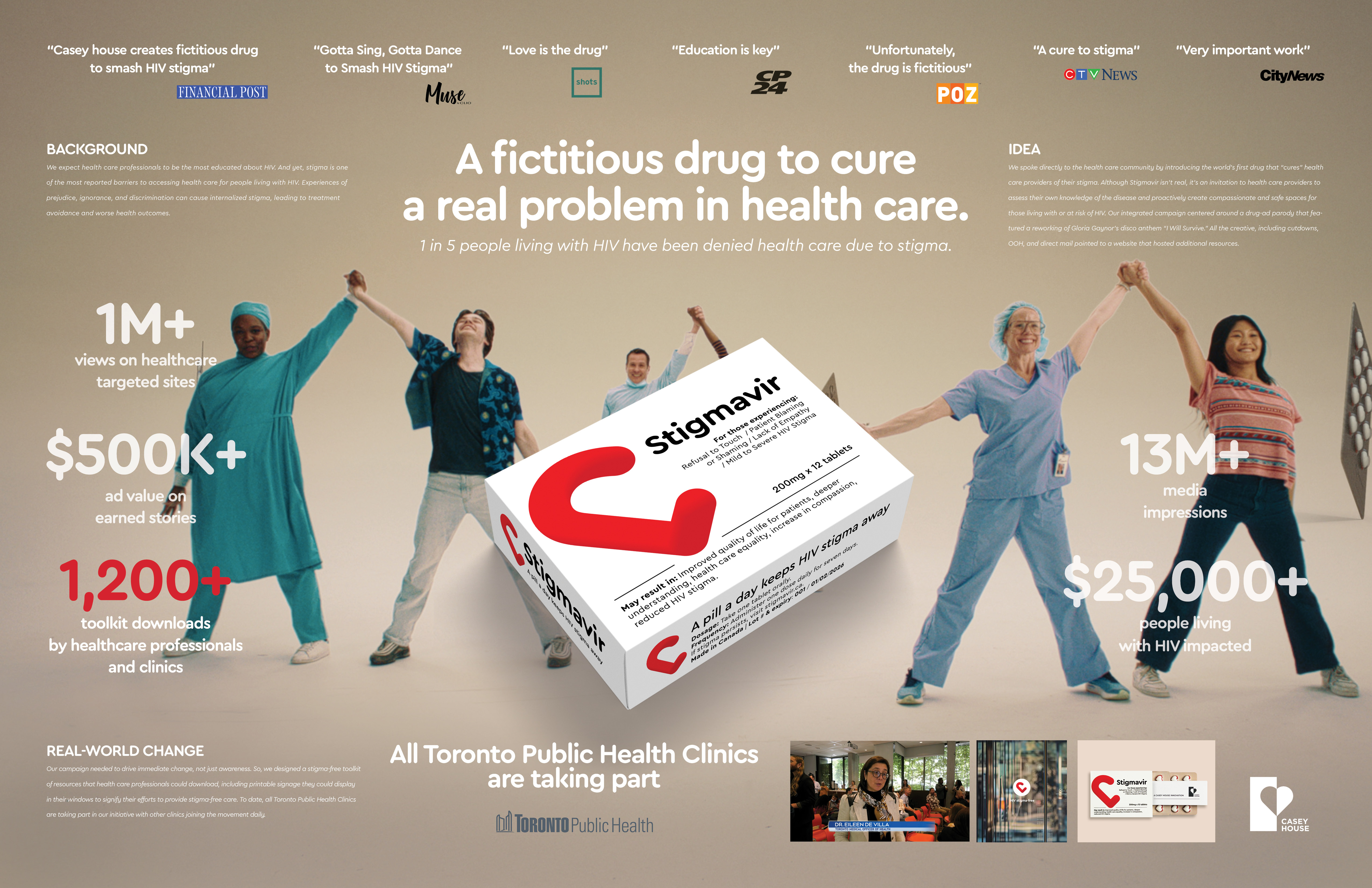
2025 Winner

GoldCause/Public Service
SilverB2B Strategy
SilverBudget-Savvy Strategy
SilverConnection Strategy
BronzeDEI Strategy
Casey House
"Stigmavir"
Bensimon Byrne
"Stigmavir"
Bensimon Byrne
CASE SUMMARY
Casey House is a specialty hospital in Toronto, unlike any other, providing groundbreaking care to people living with and at risk of HIV. Beyond its medical expertise, Casey House is also a leader in advocacy, spearheading initiatives to combat stigma and foster empathy.Now in its fifth year, the #SmashStigma campaign has grown into the largest and most impactful campaign combating HIV stigma globally. While public perception has evolved, their research revealed that stigma within healthcare settings remains an overlooked and deeply damaging issue. People living with HIV, particularly those facing intersectional challenges such as mental illness, substance use, homelessness, racism, and other systemic inequities, are significantly more likely to avoid disclosing their status to healthcare professionals due to fear of compounded stigma.
The strategy emerged from a startling truth: the greatest harm caused by HIV stigma happens inside
the very institutions meant to provide care.
Through intimate interviews and focus groups with people living with HIV, specifically those navigating intersectional challenges, and Casey House staff, they set out to understand how stigma persists today.
What their experiences revealed was both painful and urgent: stigma wasn't just a societal issue — it was embedded in the healthcare system itself.
They heard distressing stories of judgment, dismissal, and outright denial of care from trusted medical providers — like a person living with HIV who visited seven different dentists before finding one willing to accept them as a patient, or a healthcare professional who insensitively double-gloved during treatment, amplifying feelings of shame and isolation. These lived experiences were further validated by research from The Positive Effect, an HIV advocacy group in Canada, which found that 1 in 5 people living with HIV has been denied healthcare due to stigma and discrimination. These insights underscored an urgent and necessary call for accountability.
Through bold messaging and a satirical “drug” that treats stigma, they reframed the issue as one that
healthcare providers needed to own and address. This approach unlocked new relevance for Casey House and pushed boundaries for what healthcare marketing could look like.
“Stigmavir”: The world’s first drug designed to “cure” healthcare providers of stigma.
They spoke directly to the healthcare community by introducing the world’s first drug designed to “cure” healthcare providers of stigma. While entirely fictitious, “Stigmavir” served as an invitation for professionals to reassess their knowledge of HIV and take proactive steps toward creating stigma-free environments.
The campaign was anchored by a parody drug ad featuring a reimagining of “Gloria Gaynor’s I Will Survive”. Additional elements included direct mail, brand ambassadors on Hospital Row, OOH, and digital activations, directing them to Stigmavir.ca, where they accessed stigma-free toolkits.
The toolkit provided health care professionals with practical resources to help make their clinics stigma-free. It included educational materials on HIV stigma, best practices for inclusive care, and printable signage to visibly designate clinics as stigma-free spaces.
From the start, the agency’s strategy intentionally avoided shaming or blaming healthcare providers. Behavioural science, specifically reactance theory, shows direct confrontation triggers defensiveness, not change. By playfully reframing stigma in healthcare providers’ own pharma language, they lowered resistance and increased openness. The agency leveraged social proof through clinic signage, enabling clinics to declare themselves stigma-free, harnessing the powerful influence of peer Behaviour.
Over 1,200 healthcare practitioners downloaded their stigma-free toolkit, all achieved with a $0 media budget, as vendors generously donated media to support the initiative.
The campaign generated over 1 million vows on healthcare-targeted platforms and more than 13 million earned media impressions, valued at $350,000 USD, raising awareness of stigma in healthcare. Since launch, 50 new clinics have joined the movement each week, and the toolkit is now being adopted internationally. More than 25,000 people living with HIV have been directly impacted by stigma-free healthcare.
Endorsements from the City of Toronto and its chief medical officer added institutional credibility and helped secure widespread media coverage. Hundreds of city-run clinics have now committed to becoming stigma-free spaces. Most notably, the campaign is now part of the first-year curriculum at the University of Toronto’s Faculty of Medicine — embedding long-term change in the education of future healthcare professionals.
“Stigmavir” far exceeded expectations and elevated the brand’s voice nationally. By shifting focus from public attitudes to systemic change, this campaign is reshaping how HIV care is approached globally. All of this was accomplished with a zero-dollar media budget, with vendors stepping up to donate media to propel
their efforts.
Credits
Chief Creative Officer: Joseph BonniciSVP Strategy: Jenn Bell
Copywriter: Nathan Houseley
Copywriter: Kyle Simons
Creative Director: David Mueller
Executive Creative Director: Gints Bruveris
Designer: Feilin Fu
Agency Producer: Michelle Pilling
Business Lead: Jessica Cupola
Project Manager: Sandra Morales-Macedo
Program Director: Oliver Glover
Studio Director: Sanjay Mangar
Studio Designer: Rudy Cho
Studio Display Ad Developer: Kevin Hy
Developer: Dov Atlin
Media Planner: Karin Julman
Group Media Director: Carlo Fiore
Vice President: Lauren Baswick
Account Director: Cole Douglas
Director, Experiential: Jaclyn Kirk
Senior Account Manager: Samantha Sartor
Account Manager: Sreeja Sasidharan
Account Manager: Aaron Short
Associate Account Manager: John Sequeira
Executive Producer: Tom Evelyn
Director: Mark Gilbert
Director of Photography: Kris Belchevski
Line Producer: Adam Rodness
Casting: Mann Casting
Production Coordinator: Tyler Klementti
Choreographer: Mark Samuels
Producer: Michelle Pilling
Editor Offline: Tim Pienta
Editor Online: Jacques Parys
Producer: Tyna Maerzke
Director: Jared Kuemper
Engineer: Jared Kuemper
Colourist: Clinton Homuth
For submission inquiries, please contact Clare O'Brien at cobrien@brunico.com.
For partnership inquiries, please contact Neil Ewen at newen@brunico.com.
For partnership inquiries, please contact Neil Ewen at newen@brunico.com.